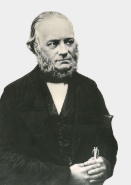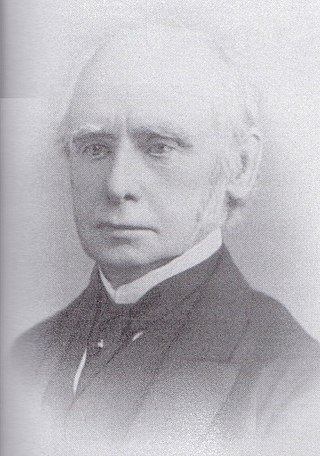Robinson and Sons Ltd was founded in 1839 by John Bradbury Robinson in Chesterfield, Derbyshire. The company started making pill boxes and grew to become a major packaging and healthcare business. [1]
Robinson and Sons Ltd was founded in 1839 by John Bradbury Robinson in Chesterfield, Derbyshire. The company started making pill boxes and grew to become a major packaging and healthcare business. [1]

John Bradbury Robinson (1802-1869) was the son of William Robinson and Ann Bradbury. The family pottery business had been running for 200 years. John B Robinson had been a retail chemist in Packer's Row, Chesterfield for 20 years when in 1839 he bought Fletcher's box manufacturing business at Middleton-by-Youlgreave. He transferred the production to Wheatbridge House in Brampton, on the edge of Chesterfield. The house had been built by John's grandfather William Robinson in 1770. During the 1840s, Robinson employed 25 people making square pill boxes from chipboard, round ointment boxes from willow and later on making turned wooden boxes. In the 1850s the business started to produce surgical dressings needed to treat the many wounded soldiers during the Crimean War. In the 1860s, the company developed medical cotton wool. John's two sons William Bradbury Robinson (1826-1911) and Charles Portland Robinson (1844-1916) joined the business as partners and the company became Robinson and Sons. [2] [3] [4]
During the 1880s, Robinsons acquired the patent from Dr Joseph Gamgee for the Gamgee tissue, using cotton wool between gauze layers, which was the basis for modern surgical dressings. Patents were also filed for the manufacture of the first sanitary towels in the 1880s. The decade also saw Robinsons working with Lord Joseph Lister to develop the first antiseptic dressings. In 1884, the Holme Brook Works was bought for production of pill boxes. In 1890, manufacture of folding boxes was introduced and in 1892 a printing department was opened. In 1893, the business was converted into a limited company, with William B Robinson as chairman. His brother Charles P Robinson and his son William B Robinson II were directors. The Walton Works were bought for dressings production in 1896. Charles P Robinson succeeded William as Chairman in 1911, followed by William B Robinson II in 1917. The Portland Works was built in 1921 near the Wheatbridge Mills to accommodate the expansion of the folding box department. In 1924, Charles W Robinson took over as chairman. [2]
During the 1920s, Robinson and Sons made initiatives to address employee welfare. Philip Moffat Robinson led the establishment of the Wheatbridge Housing Association as a way for employees to access low-cost housing. A sports club, an amateur operatic and dramatic society and the company magazine The Link were all founded. In 1928, the company bought Field House (the former home of William B Robinson II) and converted it into a large canteen and social venue called Bradbury Hall (which operated until 1984). [2]
By 1939, the company had a worksforce of 3,500 people. Colonel Victor O Robinson became chairman in 1945. A new bleach works for the Dressings Division was built at Whaley Bridge in 1950. By 1960, Robinsons employed 5,000 staff worldwide. By then Robinson and Sons' factories covered a large area by the River Hipper in Brampton. Robinson family members continued in the role of chairman with Ernest B Robinson in 1962, Charles P Robinson II in 1973, and Robert Robinson in 1978. In 1988, Tony Slipper (from Cadbury-Schweppes) became the first chairman from outside the Robinson family, with Philip Robinson as Chief Executive. [2] [5]

By 1954, one third of the carton business was producing over 43 million Quaker cereal boxes per year. In 1956, Robinsons began to produce the 'Smarties' tubes for Rowntree's. The construction was based upon the 'Little John Drum' spiral tube box invented by John Bradbury Robinson II in 1924. The Box Division was renamed the Packaging Division in 1965. It had a setback in 1969 when the National Health Service stopped using pill boxes and ointment boxes. In response, Robinsons bought I E White Ltd in 1974 to manufacture plastic containers in Kirkby-in-Ashfield as Robinson White Plastics Ltd. The Holme Brook Works closed in 1981. In 1988, a Gift Products department was established in Leeds. [2] [3]
Since 2005, the company has established sites in Poland with the purchase of a factory at Lodz and the acquisition of Madrox plastic packaging in Warsaw. The spiral wound box business based at Chesterfield was sold to Sonoco in 2011. [3]
From the late 1940s to the 1980s, the Dressings Division launched successful branded hygiene products including the 'Mene' sanitary towel, the 'Paddi' and 'Cosifits' disposable nappies and the 'Soft and Pure' range. The Dressings Division was renamed the Healthcare Division in 1987. Robinson Healthcare now specialises in single-use surgical instruments, first aid consumables and cotton wool products, from their manufacturing facility in Worksop, Nottinghamshire. [4]

Chesterfield is a market town in the Borough of Chesterfield, Derbyshire, England. It is 24 miles (39 km) north of Derby and 11 miles (18 km) south of Sheffield at the confluence of the River Rother and River Hipper. In 2011, the built-up-area subdivision had a population of 88,483, making it the second-largest settlement in Derbyshire, after Derby. The wider borough had a population of 103,801 in 2011. In 2011, the town had a population of 76,753.

Stryker Corporation is an American multinational medical technologies corporation based in Kalamazoo, Michigan. Stryker's products include implants used in joint replacement and trauma surgeries; surgical equipment and surgical navigation systems; endoscopic and communications systems; patient handling and emergency medical equipment; neurosurgical, neurovascular and spinal devices; as well as other medical device products used in a variety of medical specialties.

Dronfield is a town in North East Derbyshire, England, which includes Dronfield Woodhouse and Coal Aston. It lies in the valley of the River Drone between Chesterfield and Sheffield. The Peak District National Park is three miles (4.8 km) to the west. The name comes from the Old English Dranfleld, probably meaning an open land infested with drone bees.
Gamgee Tissue is a surgical dressing invented by Dr. Joseph Sampson Gamgee in Birmingham, England, in 1880.
GE HealthCare Technologies, Inc., doing business as GE HealthCare, is an American multinational medical technology company headquartered in Chicago, Illinois. It was spun-off from General Electric on January 4, 2023, with GE retaining 20%. As of 2017, it is a manufacturer and distributor of diagnostic imaging agents and radiopharmaceuticals for imaging modalities used in medical imaging procedures. It offers dyes used in magnetic-resonance-imaging procedures; manufactures medical diagnostic equipment, including CT image machines; MRI, XRAY; Ultrasound; Cath Labs; Mammogram; Nuclear Medicine Cameras; and develops Health technology for medical imaging and information technologies, medical diagnostics, patient monitoring systems, disease research, drug discovery, and biopharmaceutical manufacturing. It was incorporated in 1994 and operates in more than 100 countries.

Sir Robert Robinson was a British organic chemist and Nobel laureate recognised in 1947 for his research on plant dyestuffs (anthocyanins) and alkaloids. In 1947, he also received the Medal of Freedom with Silver Palm.

Brampton is a suburb in the west of Chesterfield, Derbyshire. Originally a village known as New Brampton and separate from the town, it became absorbed into it over time due to urban sprawl. It is centred on Chatsworth Road, the main arterial road (A619) that connects the town with the Peak District and Manchester.

Reeve Burgess was a bus body manufacturer based in Pilsley, North East Derbyshire in the United Kingdom. It was a subsidiary of Plaxton from 1980 until its closure in 1991.

TI Group plc was a holding company for specialised engineering companies. It was based in Abingdon, Oxfordshire. It was registered as Tube Investments in 1919, combining the seamless steel tube businesses of Tubes Ltd, New Credenda Tube, Simplex and Accles & Pollock. Reynolds Tube joined the group in 1928.
Dr. Morse's Indian Root Pills was one of the most successful and enduring products to be manufactured and marketed in North America as part of the lucrative patent medicine industry, which thrived during most of the 19th and 20th centuries. Its manufacturer claimed the pills contained herbal ingredients that would help "cleanse the blood," as "impurity of the blood" was believed to be the cause of all disease.
John Morton Clayton was an English cricketer who played for Derbyshire in 1881 and 1883.

The River Hipper is a tributary of the River Rother in Derbyshire, England. Its source is a large expanse of wetlands, fed by the surrounding moors between Chatsworth and Chesterfield, known as the Hipper Sick on Beeley Moor, which is part of the Chatsworth Estate. It then passes through Holymoorside and down into Chesterfield, just south of the town centre, before flowing into the River Rother. In July 2007, parts of Chesterfield flooded when the River Hipper burst its banks during a substantial storm that caused extensive flooding in North Derbyshire and South Yorkshire. The surrounding landscape is known as the Hipper Valley.
Markham & Co. was an ironworks and steelworks company near Chesterfield, Derbyshire, England.
E. S. & A. Robinson was a British paper, printing and packaging company founded in Bristol in 1844. In 1966, it merged with John Dickinson Stationery to form the Dickinson Robinson Group (DRG) creating one of the world's largest stationery and packaging companies.
Charles Frederick Thackray (1877–1934) was a pharmacist and manufacturer of surgical instruments in Leeds.

R. Stothert’s & Sons Ltd was originally a firm of chemists founded by Richard Stothert in Atherton, Greater Manchester. They were well-known manufacturing chemists and wholesalers of Medicines and Beverages.

Charles Walker Cathcart, CBE, MB CM, FRCSEd, FRCSE was a Scottish surgeon who worked for most of his career at the Royal Infirmary of Edinburgh (RIE). As a young man he had represented Scotland at rugby on three occasions. During the First World War he jointly published an account of the value of sphagnum moss as a wound dressing which led to its widespread use by the British Army for that purpose.
Trebor is a brand of confectionery, originally a British company.

William Henry Robertson was an English physician and a leading figure behind the development of Buxton as a Victorian spa resort.

The Clay Cross Company was founded as George Stephenson and Co. in 1837 by the railway pioneer, George Stephenson. The company established coal mines, ironworks, brickworks and pipe factories at Clay Cross near Chesterfield. The company was closed in 1998.